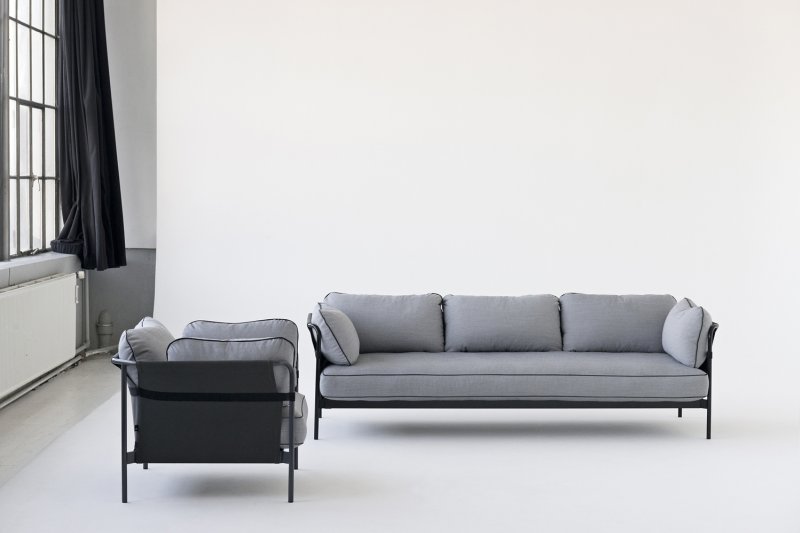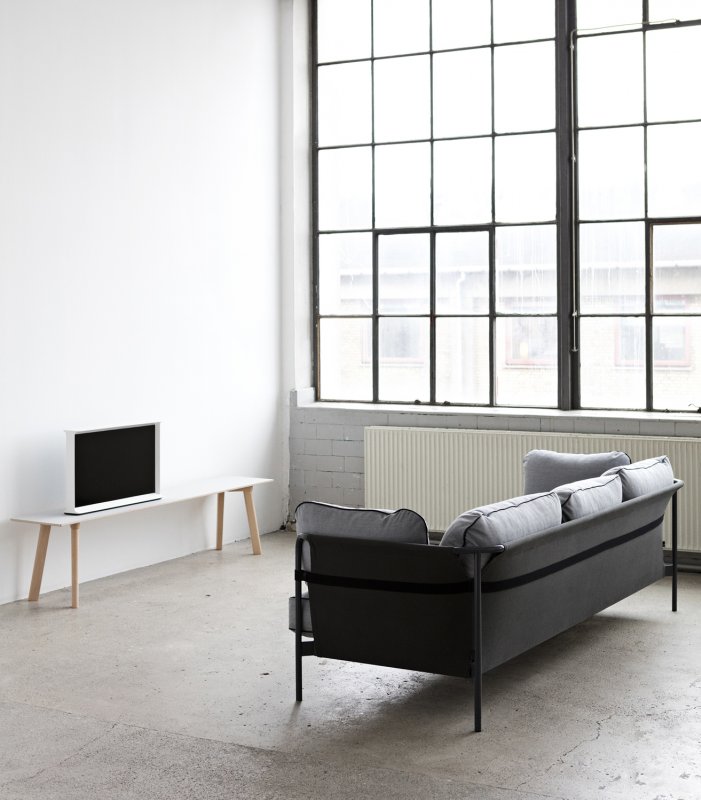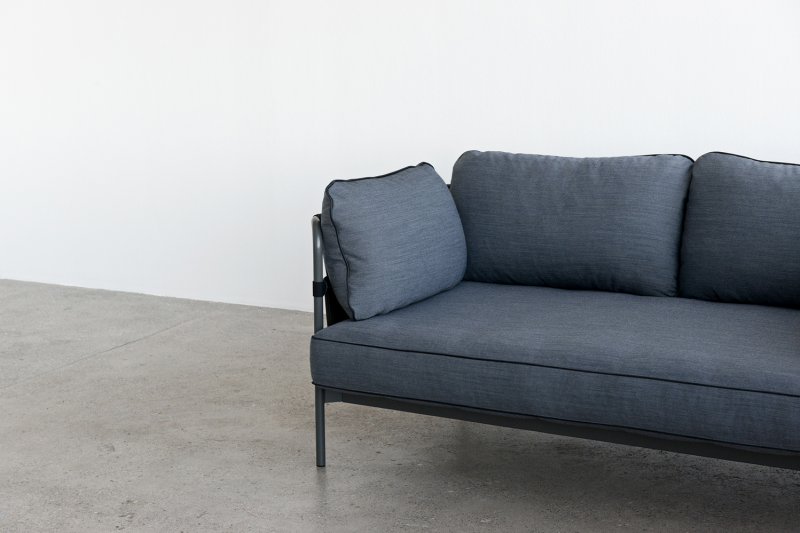Can lounge chaire - 1 seater:
L97 x W92,5 x H40/82 cm
Can sofa - 2 seater:
L172,4 x W92,5 x H40/82 cm
Can sofa - 3 seater:
L247 x W92,5 x H40/82 cm
Frame, powder coated steel tube:
Black, dark grey, light grey, red
Cover: Canvas in natural, army, grey, blue
Cushions: Canvas, Surface by Hay, Silk Leather
HAY
"CAN I DO THIS?"
AN INTERVIEW WITH ERWAN BOUROULLEC
BY DUNCAN RICHES
With the Can sofa, Ronan and Erwan Bouroullec are seeking to go
beyond the creation of a practical, elegant and comfortable design.
Their intention is actually to reinvigorate the whole idea of the sofa
itself, from something inherently complicated, to something simple,
relaxed and for everyone. I talked to Erwan Bouroullec to find out
how you go about creating a sofa design that is aesthetically,
physically and ph
ilosophically light.
PERHAPS IT IS ALWAYS best to interview people at the
beginning of the week, when everyone has “plenty of
energy,” as Montserrat, Bouroullec’s studio manager
explains to me as she powers up a set of steel stairs,
before she passes the phone on to Erwan himself. After
some brief introductions, we begin the interview, and
Erwan states quite simply “I am going to explain you
exactly how it is done and what it is.” And so he does.
The Can sofa is made from three basic elements. A frame
that is assembled from steel tubing, a set of upholstered
cushions that require “dedicated upholstery work,” and
finally, “the one important part in the sofa which we call
the canvas, which is actually made out of really strong
canvas and which is installed and then slightly spanned
onto the structure.” It is in this element that we can
understand the genesis of the idea behind the design.
“For this concept of Can, to avoid having too much
structure, we decided to span a canvas onto the structure.
By spanning the fabric you make something quite strong,
which is going to hold, while at the same time that is
soft enough to partially react to the life of the fabric.”
Erwan thinks the design “belongs a little bit to the language
of the tent and also to the furniture that were meant to
travel, daybeds you could open that would have a wood
or metal structure, with a strong canvas making the
surface on which you would lie.” This sense of lightness,
of travel, even perhaps of a kind of purposeful casualness,
all seem to have filtered into Can, also applying to how
the sofa is packaged and assembled.
The sofa itself comes flat-packed and is assembled at
home. For Erwan, this is a better solution in what he
terms the “new industrial era,” when people are keen to
get things in a quick and simple way. “It is better for all
resources, it is less transportation, less volume, less
stock, it is just much easier to do this.” In terms of how
it is assembled, if you have visions of struggling with a
tent in strong wind and rain on a far flung camping
expedition, fear not. Erwan ensures me that “It takes quite
a limited time to assemble. Of course, we know how to
build it, but some people who didn’t know, it took them
10 minutes to build the sofa, which I think is quite okay,
considering you may keep it for more than a couple of years.
It is less time than making a birthday cake, definitely.”
I wanted to gain an understanding of how the Can sofa
was prototyped and developed, how they finally brought
the design to such a balanced place. Erwan tells of how
the design was in development for at least three years,
“I don’t remember when and how, but at one point we
had a really clear vision of the sofa and then we started
to build some prototypes here in Paris, which were in
a way what it is now but without all the incredibly nice
detailing that have happened through the development.
When we sent our prototypes and drawings to the man
who has actually been developing the canvas, everything
was clear, but many issues had to be solved.” It is here
that Erwan touches on what I consider to be at the very
heart of what defines not just good designers, but truly
great ones. When and where to take, or to cede control.
As he puts it, where to leave a gap.
“At one point, it was really easy, we just had to let the
nature of the technique take the control. It means that in
the original building everything was right, then it needed
to be solved in some issues, then I knew that all the technicians
would come with a lot of nice detailing, this is
one part that I don’t want to control too much, because
all of those technicians have been stitching, they know
leatherwork, they know everything, it is even better to keep a gap and see what they propose, because there
often lies something which, in a way, has more culture
than something that I could do. I am very happy with the
end result, because it is very clear, there is a lot of detail
inside it. I love those kinds of detail, and how the culture
of the technique grows inside the object.”
Erwan sees Can as something that will wear well over
time, something that gains character in a natural way,
through use. He acknowledges that the design perhaps
runs slightly against where sofas have been heading.
“We have been using sofas that are giving more and more
softness and comfort. Here, the steel plus the canvas
are a little bit counter to this, it is not a silk shirt.” This
leads us to discuss the colour palette. “One of our biggest
games in a way, was to choose some colours that would
all go, in a way, together. So you have got many ways of
thinking “can.” You’ve got really grey on grey on grey,
really chic. Or you could go with a red frame, and build
beige on beige on beige, with the red frame bringing a
little spice inside it. Then there are many ways of kind of
playing with it, so in a way you deal a little with your
mood, either you go a little more active, or more quiet.
But what we made sure is that there wouldn’t be any
error.” The idea is that customers will be able to infuse
their Can with their own sensibility, “I think you can have
something that is quiet enough to make sure it can
travel through years, but at the same time, you can make
something a little bright.”
This freedom of expression and positive attitude has
been noticeable throughout our interview and I come to
understand how determined Erwan is to infuse the Can
sofa with these ideas. “I am always obsessed by what
people can actually do,” he explains. “Hopefully this sofa
is lightweight enough in many senses, that people are
not going to be afraid with it, there are many times when
people just can’t use the sofa, afraid they are going to
drip wine, or spill something, so sometimes the sofa is
not right for having a relaxed attitude, and this is not right.
So the name “Can” is the idea that “you can,” “you can
make it,” just don’t be afraid.





















